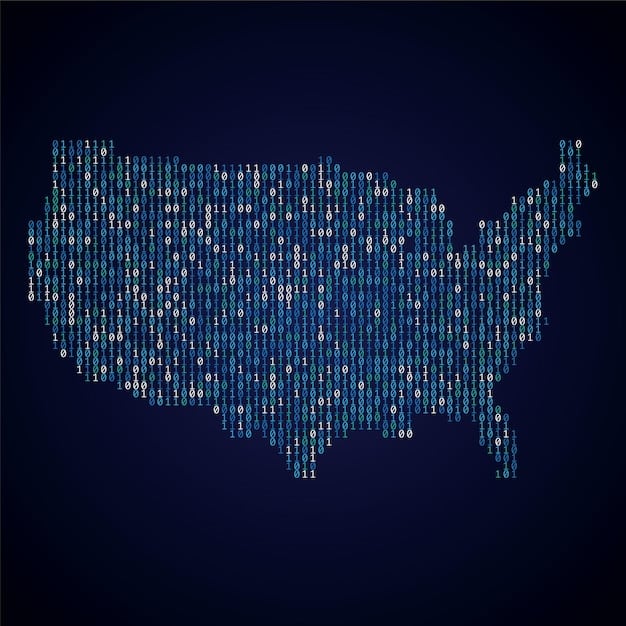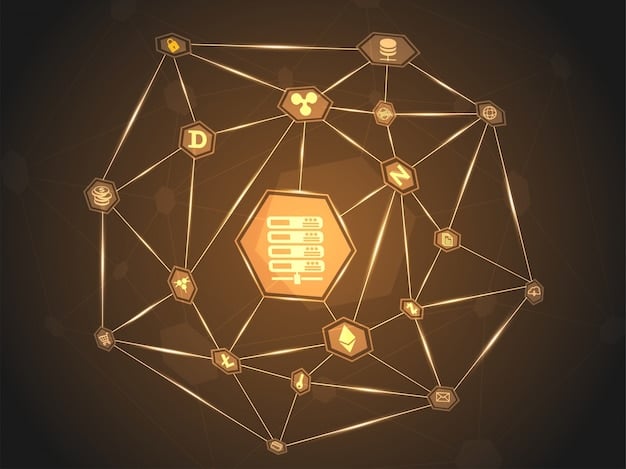Blockchain’s Impact on US Supply Chains by 2026

The integration of blockchain technology is poised to profoundly transform US supply chains by 2026, enhancing transparency, efficiency, and security through immutable ledgers and smart contracts, mitigating operational challenges like fraud and traceability issues while fostering greater trust among stakeholders across diverse industries.
In an increasingly interconnected yet often opaque global economy, the question of How Will Blockchain Technology Reshape US Supply Chains by 2026? is becoming less of a speculative query and more of an urgent operational imperative. This groundbreaking digital ledger system promises to address long-standing inefficiencies, security vulnerabilities, and complexities that have historically plagued logistical networks across the United States.
The Current State of US Supply Chains and Urgent Needs
The US supply chain system, a complex web of production, transportation, and delivery, has faced unprecedented strains in recent years. From the bottlenecks caused by the pandemic to geopolitical tensions and cybersecurity threats, its vulnerabilities have become acutely clear. This precarious state underscores a pressing need for robust, resilient, and transparent solutions to ensure the uninterrupted flow of goods and services.
Despite significant advancements in logistics and inventory management, traditional supply chains largely operate on fragmented data systems, leading to inefficiencies. Information often resides in silos, making real-time visibility and effective coordination a significant challenge for all stakeholders.
Fragmented Data and Lack of Visibility
One of the core issues in current supply chains is the pervasive lack of end-to-end visibility. Goods move, but the data often doesn’t move with the same seamless continuity. This creates blind spots, making it difficult to pinpoint issues, manage recalls, or even verify the authenticity of products.
- Delayed Information: Manual processes and disparate systems cause significant delays in data sharing.
- Incomplete Records: Data entry errors or missing information can compromise the integrity of the supply chain.
- Siloed Operations: Different departments and companies often do not share information effectively, impeding collaboration.
This fragmentation impacts everything from demand forecasting to regulatory compliance, creating a fertile ground for errors and inefficiencies throughout the entire logistical network.
Rising Costs and Security Threats
The inefficiencies inherent in traditional supply chains directly contribute to escalating operational costs. Every delay, every missing piece of information, and every fraudulent activity adds to the financial burden borne by businesses and, ultimately, consumers. Furthermore, the increasing sophistication of cyber threats poses a significant risk to the integrity and security of the entire system.
From product counterfeiting to data breaches, the current architecture offers multiple points of vulnerability that can be exploited. Businesses are constantly battling these threats, investing substantial resources in mitigation efforts that often yield only partial success.
Addressing these fundamental challenges requires a paradigm shift, moving beyond incremental improvements to a more transformative approach. Blockchain technology, with its inherent transparency and security features, emerges as a compelling candidate to usher in this new era of supply chain management.
Blockchain Fundamentals: Why it Matters for Supply Chains
At its core, blockchain is a distributed, immutable ledger that records transactions in a secure and verifiable manner. Each “block” contains a timestamped set of transactions, and once recorded, these blocks are linked together to form a “chain,” making it virtually impossible to alter past entries without detection. This fundamental characteristic provides a unique advantage for supply chain applications.
Unlike traditional centralized databases, where a single entity controls and stores all information, blockchain operates on a decentralized network. This means multiple participants maintain a copy of the ledger, ensuring data integrity and resilience against single points of failure. The consensus mechanisms employed by blockchain further validate transactions, preventing malicious data manipulation.
Immutable Ledgers and Enhanced Transparency
The concept of an immutable ledger is perhaps blockchain’s most compelling feature for supply chain management. Every step a product takes, from its origin to its final destination, can be recorded on the blockchain. This creates a transparent and auditable trail that is accessible to all authorized participants in the network.
- Real-time Tracking: Gain instant visibility into product movements and status updates.
- Authenticity Verification: Easily verify the origin and authenticity of goods, combating counterfeiting.
- Reduced Disputes: Clear, unalterable records minimize disagreements over shipments and transactions.
This end-to-end transparency not only builds trust among stakeholders but also enables faster problem-solving and higher accountability across the supply chain ecosystem.
Smart Contracts for Automated Operations
Beyond simply recording transactions, blockchain technology also enables the use of “smart contracts.” These are self-executing contracts with the terms of the agreement directly written into lines of code. They automatically execute predefined actions when specific conditions are met, eliminating the need for intermediaries and speeding up business processes.
Imagine a smart contract triggering payment release automatically once goods are delivered and verified at a certain checkpoint, or initiating a new order when inventory levels fall below a predetermined threshold. This automation streamlines operations, reduces administrative overheads, and drastically cuts down on payment delays, fostering greater efficiency within the supply chain.

Key Areas of Transformation by 2026
By 2026, blockchain’s influence on US supply chains will likely span several critical areas, fundamentally altering how goods are traced, verified, and managed. These transformations are not merely incremental improvements but represent a significant shift towards a more intelligent and resilient logistical ecosystem.
Improved Traceability and Provenance
One of the most immediate and impactful applications of blockchain in supply chains is enhanced traceability. For industries ranging from pharmaceuticals to fresh produce, knowing the exact origin and journey of a product is paramount. Blockchain provides an unalterable record for every touchpoint, from raw material sourcing to manufacturing, packaging, and distribution. This granular level of detail ensures unprecedented transparency that was previously unattainable.
Consumers are increasingly demanding ethically sourced and authentically produced goods. Blockchain can underpin this demand by providing verifiable proof of a product’s journey. This builds consumer confidence and can also aid in rapid product recalls by precisely identifying affected batches, minimizing risk and financial losses.
Enhanced Security and Fraud Prevention
Counterfeiting and fraud cost businesses billions annually, ranging from fake luxury goods to illicit pharmaceutical products. Blockchain’s cryptographic security features make it an ideal tool for combating these issues. The distributed and immutable nature of the ledger means that altering any recorded data without detection is virtually impossible, thus safeguarding the integrity of products.
By embedding unique identifiers on products that link back to their blockchain record, companies can empower consumers and partners to verify authenticity. This not only protects brand reputation but also ensures regulatory compliance, particularly in highly regulated industries where product integrity is a matter of public safety.
Streamlined Payment and Financial Processes
The financial complexities within supply chains often involve multiple invoices, payment delays, and cross-border transactions that can be cumbersome and expensive. Blockchain, particularly through smart contracts, can revolutionize these processes. Payments can be automatically triggered upon predefined conditions, such as the successful delivery of goods or verification of quality. This eliminates manual approvals, reduces reconciliation errors, and accelerates cash flow for all parties involved.
Decentralized finance (DeFi) solutions built on blockchain can also offer alternative financing options for suppliers, potentially reducing reliance on traditional banking systems and providing more flexible and cost-effective access to capital. This streamlining of financial operations will contribute significantly to overall supply chain efficiency by 2026.
Challenges and Adoption Hurdles
While the benefits of blockchain in supply chains are clear, its widespread adoption by 2026 is not without significant challenges. Overcoming these hurdles will require collaborative efforts, strategic investments, and a clear understanding of the technological and organizational shifts required.
Interoperability and Standardization
One of the primary challenges is ensuring interoperability between different blockchain platforms and existing legacy systems. Many companies have already invested heavily in their current IT infrastructure, and a complete overhaul is often not feasible. Creating seamless communication channels between various blockchain networks and traditional databases is crucial for a unified and effective supply chain ecosystem.
- Diverse Platforms: Numerous blockchain protocols exist, each with its own specifications.
- Legacy Systems Integration: Bridging the gap between old and new technologies is complex.
- Lack of Universal Standards: The absence of common data formats and communication protocols impedes seamless data exchange.
Developing industry-wide standards for data exchange and common protocols for blockchain integration will be vital to unlock its full potential across diverse sectors within the US supply chain.
Scalability and Performance
For a technology to be effective in a vast and complex system like the US supply chain, it must be highly scalable and performant. Current public blockchain networks like Bitcoin and Ethereum, while secure, can sometimes struggle with transaction speed and volume, which could be a bottleneck for high-frequency supply chain operations. Private or permissioned blockchains may offer better performance for specific enterprise applications, but they still need to demonstrate the ability to handle millions of transactions daily without sacrificing speed or security.
Research and development are actively addressing these scalability issues through various solutions, including sharding, layer-2 protocols, and more efficient consensus mechanisms. The success of these advancements will largely dictate how quickly decentralized supply chain solutions can be deployed at scale across the nation.
Regulatory Landscape and Legal Framework
The evolving nature of blockchain technology also presents a complex regulatory environment. Governments and regulatory bodies are still grappling with how to effectively oversee and incorporate blockchain into existing legal frameworks, particularly concerning data privacy, immutable records, and the legal enforceability of smart contracts. A lack of clear regulations can deter adoption, as businesses might be hesitant to invest in technologies whose legal standing is ambiguous.
Establishing clear guidelines for data governance, ensuring compliance with privacy laws like GDPR (even though it’s European, its principles influence global data practices) and new US state data privacy acts, and defining the legal validity of smart contracts will be crucial for building trust and encouraging widespread adoption across US supply chains by 2026.

Emerging Use Cases and Industry Adoption
Despite the challenges, several sectors within the US economy are actively exploring and implementing blockchain solutions for their supply chains, showcasing its practical utility and the tangible benefits it can deliver. These early adopters are setting precedents and providing valuable case studies for broader implementation.
Food and Agriculture Sector
The food industry faces constant pressure regarding product safety, recalls, and consumer demand for transparent sourcing. Blockchain offers an unprecedented level of traceability, allowing consumers to scan a QR code and instantly access information about where their food came from, how it was grown, and its journey through the supply chain. This transparency builds trust and helps identify contamination sources rapidly during outbreaks, minimizing public health risks and economic losses.
Major retailers and food producers are already piloting blockchain-based solutions to enhance food safety and supply chain visibility, setting a new benchmark for accountability and quality control in the agricultural sector.
Pharmaceuticals and Healthcare Logistics
In the highly regulated pharmaceutical industry, product integrity and anti-counterfeiting measures are critical. Blockchain can track prescription drugs from manufacturer to patient, ensuring their authenticity and preventing the distribution of counterfeit medications. This not only safeguards public health but also helps companies comply with stringent regulations like the Drug Supply Chain Security Act (DSCSA) in the US, which mandates an electronic, interoperable system to identify and trace certain prescription drugs.
Beyond drug traceability, blockchain can also streamline medical device logistics and manage patient data securely (with appropriate privacy safeguards), enhancing overall efficiency and trust within healthcare supply chains.
Retail and Consumer Goods
The retail sector, with its complex global supply chains and increasing focus on sustainability and ethical sourcing, is another ripe area for blockchain adoption. From tracking the origin of materials for clothing to verifying fair labor practices, blockchain can provide verifiable proof of a product’s ethical journey. This resonates with conscious consumers and allows brands to build stronger relationships based on transparency.
Additionally, blockchain can optimize inventory management, reduce returns due to counterfeit products, and enhance customer loyalty programs by providing transparent and secure rewards mechanisms. These applications promise to reshape the retail experience for both businesses and consumers.
Future Outlook and Strategic Imperatives
Looking ahead to 2026 and beyond, blockchain technology is poised to become an increasingly integral component of US supply chains, driving a new era of efficiency, resilience, and ethical conduct. However, realizing this potential requires strategic foresight and a concerted effort from all stakeholders.
Interoperability as a Priority
For blockchain to achieve its full transformative potential, the industry must prioritize interoperability. This means developing common standards, APIs, and cross-chain solutions that allow different blockchain networks and legacy systems to communicate seamlessly. Without this, the ecosystem risks fragmentation, limiting the network effects that are crucial for widespread adoption and data sharing across the vast US supply chain landscape.
Collaborative initiatives between technology providers, industry consortia, and government bodies will be essential to establish these foundational standards and foster a more connected supply chain environment.
Education and Workforce Development
The successful integration of blockchain will also depend on a skilled workforce. There is a growing need for professionals who understand both supply chain logistics and blockchain technology. Investment in education and training programs is crucial to equip the current and future workforce with the necessary knowledge and skills to implement, manage, and innovate with blockchain-powered supply chain solutions. This includes not just developers, but also legal experts, business strategists, and operational managers.
Regulatory Clarity and Government Support
Finally, a clear and supportive regulatory environment will be critical. As blockchain technology matures, governments need to provide definitive legal frameworks concerning data ownership, privacy, smart contract enforceability, and cross-border data flow. Proactive engagement from policymakers, fostering sandboxes for innovation, and providing incentives for blockchain adoption can significantly accelerate its integration into US supply chains, creating a more secure, transparent, and resilient national economic infrastructure.
| Key Point | Brief Description |
|---|---|
| 🔗 Traceability | Blockchain offers unalterable records for end-to-end product journey, enhancing transparency. |
| 🛡️ Security | Combats fraud and counterfeiting through cryptographic security and immutable ledgers. |
| 🤝 Automation | Smart contracts automate payments and operations, reducing delays and intermediaries. |
| 💡 Challenges | Includes interoperability, scalability, and evolving regulatory frameworks. |
Frequently Asked Questions About Blockchain in Supply Chains
▼
Blockchain is a decentralized, distributed ledger that records transactions in an immutable and transparent manner. In supply chains, it’s used to create an unalterable record of product movements, ownership transfers, and other critical data, enhancing traceability, security, and efficiency across the entire network from raw materials to consumer.
▼
By recording every step of a product’s journey on an immutable ledger, blockchain provides real-time, end-to-end visibility. This allows all authorized participants to see where a product is, its origin, and its handling history, greatly reducing information silos and enabling faster issue resolution in complex logistical networks.
▼
Smart contracts are self-executing contracts with the terms of the agreement directly written into code. In supply chains, they automate actions like payment releases upon verified delivery, or ordering new inventory when stock levels drop. This automation streamlines processes, reduces administrative bottlenecks, and minimizes the need for intermediaries.
▼
Key challenges include ensuring interoperability between diverse blockchain platforms and legacy systems, addressing scalability concerns for high transaction volumes, and navigating an evolving regulatory landscape regarding data privacy and the legal standing of smart contracts. Overcoming these requires industry collaboration and clear guidelines.
▼
Industries like food and agriculture, pharmaceuticals, and retail are at the forefront of blockchain adoption. They leverage the technology for enhanced traceability, combating counterfeiting, ensuring product safety, and complying with stringent regulations, demonstrating practical and impactful use cases across various complex supply networks.
Conclusion
By 2026, blockchain technology is on a clear trajectory to fundamentally reshape US supply chains, moving them from reactive and opaque systems to proactive, transparent, and highly efficient networks. While challenges surrounding interoperability, scalability, and regulation persist, the demonstrable benefits in traceability, security, and automation are compelling. As industries increasingly recognize its potential to mitigate risks, cut costs, and build greater trust, blockchain will evolve from a niche technology to an indispensable component, driving a new era of resilience and accountability across America’s logistical infrastructure.





